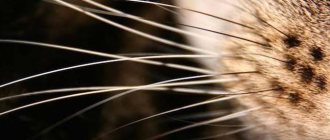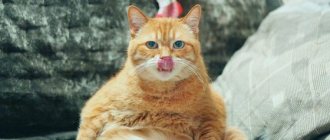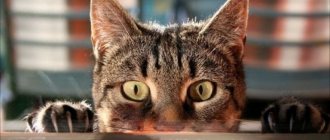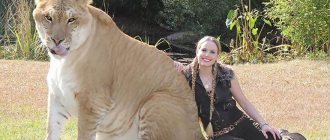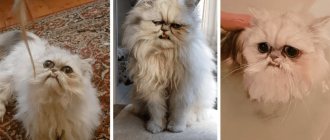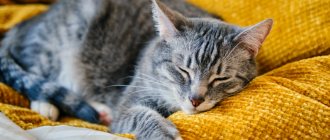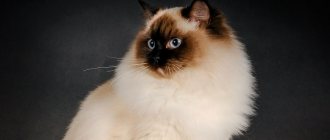Domestic cats, representatives of wild animals, were revered in Ancient Egypt. They were worshiped, idolized and even sacrificed to them. But with the advent of the Middle Ages, attitudes towards cats changed dramatically. They began to be considered the mediator of evil spirits in our world.
Dogs are considered to be the first animals that humans began to domesticate. Since ancient times, these animals were in close proximity to humans and their homes, helping to hunt and guard the house, protect themselves from predators and ill-wishers. As for cats, everything is much more complicated. Until now, scientists have not solved the mystery of the appearance of domestic cats, and why people decided to make them a popular pet.
Turkish Angora
According to one version, the ancestor of the breed was a wild forest Pallas cat, who lived in the Middle Ages on the territory of the Ottoman Empire. According to another version, it is believed that the breed originated from the Libyan steppe cat, inhabiting the territories of Africa and the Middle East. The exact origin is quite difficult to establish, because the angora appeared several thousand years ago. What is known for certain is that the cats were bred in the Turkish city of Angora, where the name of the breed came from.
The Turkish Angora has always been held in high esteem by aristocrats and rulers. Long-haired white cats attracted attention with their charm and extraordinary grace. In ancient times, representatives of the breed with different eye colors were especially valued. It was believed that such pets bring wealth and prosperity to the home.
Origin
There are two main versions of where these pets came from:
- biblical;
- scientific
Biblical theory is familiar to adults and children. She says that the cat came from the ark, which Noah made to save animals from the flood. After the ship was built, Noah stroked the lion and a pair of these animals appeared from the nostrils - a male and a female. They were taken into the ark, and they thanked them by saving them from the invasion of rats and mice.
The second version is scientific. It says that cats originated 60 million years ago. Animals migrated from one habitat to another. There are opinions that the origin of cats has African and Asian roots. They crossed and gave birth to the modern cat. According to research by scientists, it is believed that the immediate ancestor of cats is the prehistoric Proaiurus. Outwardly, it looked like a marten, was large in size and weighed about 9 kg.
One of the scientifically substantiated facts is that the pet descended from Proailurus.
Ancestors of cats
The first representative is creodont. It lived 50 million years ago and was large in size. These are predatory animals. Following them, lions, tigers, and cheetahs began to appear. Long-legged Libyan cats live in Africa. They have a long sharp muzzle, stripes on the body, dark rings near the tail. She is considered the second ancestor. Indian steppe cats live in India, Iran, and Asia. They are much larger than domestic ones, have a gray-yellow coat color, and a long tail. Some scientists consider these pets to be the predecessors of seals. Ancestors include the magota, ocelot, and Bengal cat. The oldest prehistoric ancestors of domestic cats are saber-toothed tigers. They were unlike a modern animal. They were distinguished by their huge sharp fangs, with which they tore the victim into pieces. The ancient feline descendant is the forest cat and another wild representative (lynx).
The ancestor of modern fluffies, who lived many millions of years ago, is considered to be the saber-toothed tiger.
The number of descendants is about 37 species of the cat family.
Persian cat
Persian cats are such an ancient species that it is no longer possible to determine their exact origin. Its roots go back to ancient Persia, now the territory of Iran. It was from there that in 1622 the traveler Pietro della Valle brought several Persian cats to Italy. The breed received its official recognition in the 19th century in England. This country is considered the second homeland of the Persians. It was here that painstaking selection work began to improve the breed and develop new varieties.
From Europe, the Persian cat came to America, where work continued to improve and diversify its external qualities. It was in the USA that the exotic shorthaired variety of Persians was first bred.
Persian long-haired beauties appeared in Russia only at the end of the 20th century. Amazingly beautiful animals with an unusual nose shape were brought to us by diplomats from Europe in the 80s.
The Persian appearance is distinguished by a snub nose and large, expressive eyes. Initially, only blue color was recognized among Persians. At the moment, the breed has about a hundred varieties differing in coat length, color and body structure.
Sphinx food
Character: intelligent, inquisitive and demanding. Syjami are very talkative and do not like to be ignored.
Pros: Elegant, smart, intelligent. They get along well with children and easily get used to collars and leashes.
- Cons: very demanding and active work. They don't like to be alone, they don't like to sit in a cage, they are very talkative. They need warmth.
- History: The conquest of Europe by Thai cats began at the end of the 19th century. At that time, about ten Siamese cats were brought to England, and some differences in body construction can be seen. Consequently, 2 types of cats were distinguished: one with a strong structure and a rounded head (the ancestors of the modern Thai), and the other with more shaped animals with an elongated head (the ancestors of the modern Siams). Currently, Thai cats come in three types: classic, traditional and modern. Along with changing the name of the race, more attention was paid to its purity.
Diet for a kitten
Appearance: The WCF standard requires the Thai cat to have a round head and a prominent chest. It is quite massive, but this massiveness should not be feared. Its oriental origin highlights my almond-shaped eyes and slightly spaced ears. As a result of numerous crossword puzzles, the integration of Thai cats has become quite diverse, and now cream, red, tabby and tortoise have been added to the original Blu-, Power-, lilac dot and chocolate flowers.
Character: Thai cats have an equal, balanced temperament. This Cat breed can be a great companion for one person or a child for a child. All the myths about Vengyphum of Thai are just myths that have nothing to do with reality. The Thai cat is characterized by high intelligence. Breeders of this breed, answering the question “Why does a Thai cat have a big forehead?” - they joke: “Because for such an ideal brain you need a lot of space!”
Pros: Excellent health.
Cons: The Thai cat population has been impacted by accidental breeding over the years, causing traditional Thais to evaporate the metars. This has led to the current difficulties in Genas Pula.
History: Apparently, the first Russian blue cats were brought to England from Arkhangels via sailors. Although they were called both Maltese and Spanish cats before 1900, many factors point to a Russian origin for the race.
Appearance: long flexible and slender body, long tail. Short, thick, silky fur, pure blue, without tints or white hair. The head is wedge-shaped with a simple nose. The eyes are almond-shaped, widely set, light green in color.
Character: shy and quiet, very attached to the owner. It's easy to tolerate living in an apartment.
Pros: good temperament, calm and sociable. Easy hair care. He can live well in an apartment in the city.
Diet for an adult
Cons: very soft: if the cat is closed, gentle will not help in the rescue.
Other names: Arkhangelsk cat, Maltese cat.
History: The Persian cat is one of the oldest and still most popular cat breeds, but its exact origins are not entirely clear. It is known that long-haired cats appeared in Europe back in the 16th century, receiving their name from Persia (Iran), where they were brought from.
Ready-made feed
Appearance: Over many years of breeding, we have managed to develop a characteristic type of Persian cat that cannot be confused with any other. The body is stocky and compact, the legs are short and thick. The head is wide, round, massive. The nose is short, pointed, with a pronounced stop. But the most important thing is the hair: long (up to 15 cm) and thick, silky to the touch, with a fluffy collar at the head. For lovers of short hair, there is a breed of “short-haired Persians” - exotic (exotic).
Personality: Persians are unpretentious, unpretentious and calm. They are obedient, quiet, gentle and friendly. They need to be protected because they cannot always escape danger.
Recognized by associations: FIFe, CFA, WCF.
Pros: Unforgettable appearance and calm character. Persian cats are affectionate, sociable, and easy to live with.
Sphynx weight by month
Cons: Daily care is required; lint that is not removed on time is very difficult to remove. The variety is prone to injury and sheds leaves abundantly, especially in summer. Touchy, does not like to be teased.
Celebrity: Colonel Meow
History: I define Oriental cats as Siamese, but without a specific color pattern on their coat. Ancient Thai manuscripts contain images and descriptions of not only Siamese cats, but also fully colored, short-haired, elegant cats. These cats, along with Siamese cats, came to Europe at the end of the 19th century. Wilga received official recognition in the early 1970s in England and around the same time in the United States.
Appearance: The body is elongated, slender and muscular. The head is wedge-shaped with a long straight nose. The eyes are medium-sized, almond-shaped, translucent. The ears are large and pointed. Long slender legs. The legs are small and oval. The tail is long, thin and pointed.
Personality: Smart, intelligent, affectionate, inquisitive, active, has a bright personality. Oriental dogs become attached to their owners; they are very sociable and focused on communicating with people.
Siberian cat
The Siberian cat breed has ancient origins. The animals were bred on the territory of our country. The ancestors of the breed are wild steppe cats that crossed with domestic cats brought from other countries. The exact date of appearance of the long-haired beauties is unknown. But it is believed that all cats described in Russian folk tales are representatives of the Siberian type.
Siamese cats
The modern territory of Thailand is considered the homeland of the Siamese. In ancient times, this state was called Siam. It was several centuries ago that extraordinary cats with amazing colors first appeared here.
Siamese cats have long been considered sacred animals; exporting them outside the country was strictly prohibited. The breed enjoyed special respect and was protected by law. In Europe, blue-eyed beauties appeared only in the 19th century. The first Siamese were brought to England by the widow of a British officer, Anna Crawford. The woman served as a governess to the children of the King of Siam, and it was here that she first saw Siamese cats, which won her heart. Returning home after the end of her service, Anna took with her several individuals of this breed. The Siamese breed quickly became incredibly popular. In 1901, the Siamese Cat Club was organized in Britain, and in 1902, breed standards were first described and adopted.
Now Siamese are valued all over the world for their bright exterior and excellent character. Currently, this ancient breed is one of the few that has retained its original appearance. The appearance of the modern Siamese cat almost completely coincides with the descriptions of the Siamese of the 18th-19th centuries.
Cats are very mysterious creatures; many myths and legends are associated with them. These pets simultaneously combine affection for humans and a freedom-loving, independent character inherited from their wild ancestors. Despite the centuries-old history of friendship between cats and humans, felines still hide many mysteries.
Contents in the house
A cat's head made of baked clay was found on the island of Crete, which is at least 3,400 years old. A 2,500-year-old marble slab was discovered in Greece showing a cat fighting with a dog as two men watched.
According to one version, the birthplace of the first domestic animals was Ancient Egypt. The death penalty was imposed on anyone who killed an animal, intentionally or accidentally. Cats were considered sacred animals in Egypt.
- They quickly replaced ferrets, which were trained to catch rats and mice in granaries. They were depicted on vases and coins.
- Caring for an animal was considered an honorable occupation; it was passed down from father to son. In case of death, the whole family mourned the cat and gave him a wonderful funeral.
- There was a strict ban on export from the country. Many Greek smugglers tried to take possession of the Egyptian cat, and even the threat of death for the crime did not stop them.
- Eventually the animal found its way to Greece and from there to Rome. Having firmly established itself in the ancient world to conquer Europe, the animal was in no hurry and was still a rarity in the 11th century. In Rus', judging by the mentions, they were not common until the 14th century.
- Animals had a hard time in medieval Europe. Misfortunes and disasters were associated with them. It was only in the 18th century that they began to be hunted. But it took almost a hundred years for ancient cats to be accepted as pets.
- Today it is impossible to name the most ancient breed of cats. There is no evidence to support the age superiority of any race. But there are races that have been talked about for millennia.
- Siamese (Thai).
- This breed is traditionally considered one of the most ancient. The animals were first described in the ancient book (1350-1767) “Poems about Cats”; there are also their images. These animals were worshiped throughout Siam in the fourteenth and fifteenth centuries. They were considered guardians of temples and guardians of the souls of the dead. Thanks to them, Siam was born, and Siamese traditions were called “Thai”, and their homeland began to be called Thailand.
- Egyptian Mau
Images in which the spotted Egyptian is quite recognizable appeared more than 3,000 years ago. And the first mentions of them date back to the 5th century BC. and were compiled by Herodotus. Cats of this ancient breed have extremely developed hunting abilities and can reach speeds of up to 58 km/h.
Train to the tray
Turkish Angora
One of the oldest breeds, the Turkish Angora, gets its name from the capital of Turkey, where semi-long-haired white cats have been bred since the 14th century. There was a strict ban on the export of animals.
Turkish Van
The most ancient cat breeds
Have you ever wondered which breed of domestic cat is the oldest? Several breeds claim the title, some of which have a history of thousands of years, but it is not known exactly which of them is truly the oldest.
Persian cat
Like the Angora, the Persian cat has long hair. And since the Angora is considered the first cat to have long hair, this means that the Persian is not as ancient as the Angora. However, again, this causes a lot of controversy, and there is no clear opinion on this matter.
The Persian cat originated in Persia, which is today known as Iran. Long-haired cats were first described in Europe in the 1400s, but exactly what breed they were is not known. It is very likely that these European longhaired cats are the ancestors of modern Persian cats.
Siberian cat
This breed is also known as the Siberian forest cat. The breed has a long history and originates in Russia. It is believed that the Siberian is also the ancestor of all modern long-haired cats. The Siberian forest cat is probably closely related to the Norwegian forest cat. This cat was one of 3 longhaired breeds that were described during the first cat show in England in the 1700s.
Sphynx care
Pros: Gentle, active, smart and loving. They get along well with people and other animals.
- Cons: Requires company and physical activity (eg games), likes warmth.
- jungle-cats.by.ru
- History: The Norwegian wild cat has lived alongside people for several centuries. One of the earliest mentions of skogkat is the famous chronicle "Prose Edda". (Legend has it that the mighty god Thor suffered one of his greatest failures - he could not pick up a cat). It is likely that among the ancestors of the Nordics there were animals from both southern Europe and Asia.
Skin care
Appearance: The appearance of the animal was greatly influenced by the harsh Scandinavian climate. Norwegian Forest Cats are large, well-built animals with long, water-repellent coats and a thick undercoat. The head is triangular, the nose is wide and straight. The ears are set wide apart, with fringe at the tips, and a ribbed collar around the neck.
- Personality: Active, freedom-loving and affectionate. They like to play. Norwegians are very rough, but at the same time they have true Scandinavian resilience.
- Pros: Handsome, strong, good hunter, waterproof coat.
- Cons: Requires daily care, sheds heavily in spring and summer. They prefer to live outdoors or free-range.
Abyssinian cat
Of all the ancient breeds, the Abyssinian probably has the most confusing and controversial origins. Some believe the breed's origins go back to ancient Egypt, as it resembles many artifacts from that time. Of course, the modern Abyssinian cat is very different from its ancestor. The now famous breed was developed using Burmese, Russian Blue and Siamese cats.
Egyptian Mau
The Egyptian Mau is probably truly the oldest or oldest breed of domestic cat. These cats have a natural spotted color. Apparently, the modern Egyptian Mau looks almost the same as it did 3,000 years ago. There is ancient artwork that dates back over 3,000 years that depicts cats that look like modern Mau.
The most famous mustachioed centenarians
Several long-lived cats are included in the Guinness Book of Records. These amazing animals lived interesting and active lives. The age champions were:
- Lucy the cat, who lived 43 years. Lucy was born in the town of Lanelli, UK. The owner B. Thomas claimed that his cat hunted mice until the last day, was active and cheerful, but her only illness was complete deafness. It should be noted that this record was not recorded in the Book of Records, since it could not be officially confirmed.
- Cream Puff is officially considered the oldest feline. Cream died at the age of 38 years and 3 days. Her hometown is Austin, Texas. Owner Jake Perry believes the pet has been around for so long thanks to proper nutrition. Her diet included only natural foods, such as broccoli, eggs, asparagus and bacon.
- Kitty from England. A small cat who lived for 30 years and was able to surprise her owner D. Johnson at the end of her life. The elderly pet gave birth to two adorable kittens, completely healthy. The stunned owner did not expect this from his “old lady,” but was incredibly happy.
- Blackie. Born in England, her owner Quentin Shaw did not expect the pet to live a full 25 years. The most amazing thing is that the fluffy beauty survived three of her litters. Until the end of her life, the cat felt great, and suffered only from poor eyesight.
